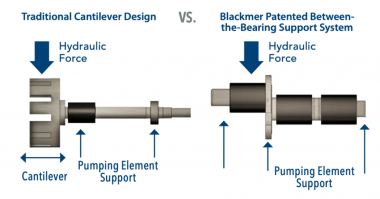On the diagram in the video, ANSI/HI Standard 1.1-1.2, you can start seeing a lot of different varieties of centrifugal pumps designed for different types of applications. The diagram shows what would be considered an overhung pump and what that means is the impeller is actually overhanging inside the pump’s construction. The shaft is only providing support on the impeller from one side. There’s a wide variety of these pumps and you can break them down (as the ANSI/HI standard does) into what would be considered flexibly coupled pumps, rigidly coupled pumps, or close coupled pumps.
A flexibly coupled pump is a pump that is going to be mounted on some form of a base plate that would require a motor to be mounted on that same support structure. Alignment between the motor and the pump will be required and they will be coupled with some sort of a flexible coupling that will then pass the motor power or torque onto the pump.
A rigidly coupled pump is one that the pump and the motor will be rigidly aligned with some sort of a structure, adapter, or bracket. The coupling that goes between the two is going to be a rigid coupling that does not allow for misalignment. The alignment has to be done very accurately in the assembly of the pump and motor.
A close coupled pumps is where the impeller is directly mounted on the motor shaft. As you’ll see in the example in the video, a close coupled style is where the impeller is mounted directly on a motor shaft and there’s no coupling required.
As you break down the different categories, you’re going to have horizontal pumps where the pump is mounted in a horizontal orientation and vertically mounted pumps where the pump is essentially mounted vertically, the motor is vertical, and the flow will come in more of a horizontal nature in the pump.
There’s a wide variety of different pump designs based on the system requirements and how the system needs to operate. There’s also a whole classification of what would be considered ‘between bearing pumps.’ What makes it between the bearing pump is that you’ll have a shaft that has bearing support on both sides of the shaft and then in the middle of that shaft is the impeller. So, it’s no longer an overhung load on the shaft, it’s actually between the bearing load. You’ll typically see this on higher energy, higher flow pumps because the shaft or the impeller in the hydraulic design of these pumps will provide such a high radial load that you need to have that between the bearing support to ensure that you’re not overloading the shaft causing excessive shaft deflection.
Finally, there are other centrifugal pumps that are classified as ‘vertically suspended pumps.’ You’ll also have heard of them as vertical pumps or vertical turbine pumps. These are pumps that’s actually vertically suspended and can be dropped down into open pits or for any other environments that need the pump to be operated in a vertical nature.
Watch more Centrifugal Pump Minutes!




Comments